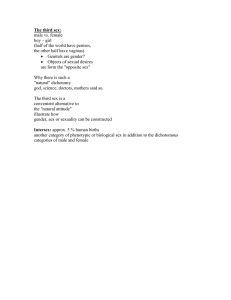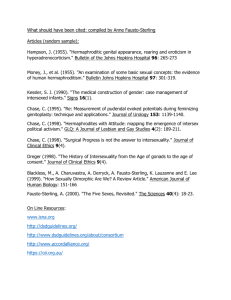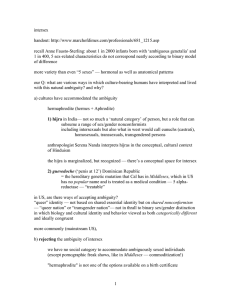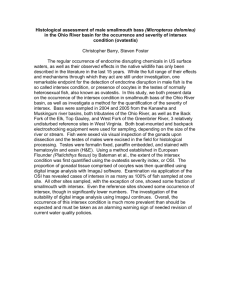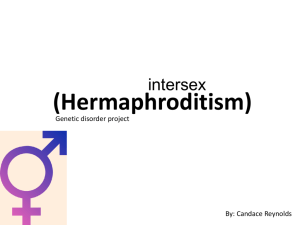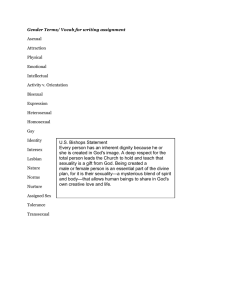From Social Construction to Social Justice
advertisement
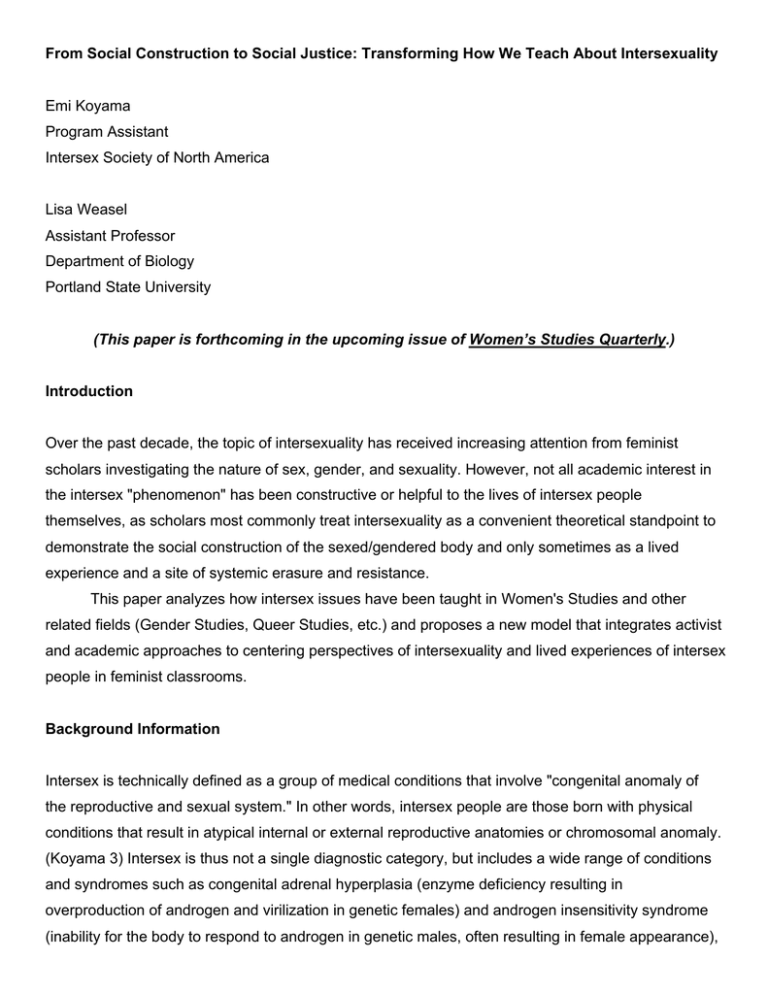
From Social Construction to Social Justice: Transforming How We Teach About Intersexuality Emi Koyama Program Assistant Intersex Society of North America Lisa Weasel Assistant Professor Department of Biology Portland State University (This paper is forthcoming in the upcoming issue of Women’s Studies Quarterly.) Introduction Over the past decade, the topic of intersexuality has received increasing attention from feminist scholars investigating the nature of sex, gender, and sexuality. However, not all academic interest in the intersex "phenomenon" has been constructive or helpful to the lives of intersex people themselves, as scholars most commonly treat intersexuality as a convenient theoretical standpoint to demonstrate the social construction of the sexed/gendered body and only sometimes as a lived experience and a site of systemic erasure and resistance. This paper analyzes how intersex issues have been taught in Women's Studies and other related fields (Gender Studies, Queer Studies, etc.) and proposes a new model that integrates activist and academic approaches to centering perspectives of intersexuality and lived experiences of intersex people in feminist classrooms. Background Information Intersex is technically defined as a group of medical conditions that involve "congenital anomaly of the reproductive and sexual system." In other words, intersex people are those born with physical conditions that result in atypical internal or external reproductive anatomies or chromosomal anomaly. (Koyama 3) Intersex is thus not a single diagnostic category, but includes a wide range of conditions and syndromes such as congenital adrenal hyperplasia (enzyme deficiency resulting in overproduction of androgen and virilization in genetic females) and androgen insensitivity syndrome (inability for the body to respond to androgen in genetic males, often resulting in female appearance), 2 just to name two. The estimated frequency of intersex conditions varies depending on how the definition is applied, but it is assumed that one in 2,000 babies in the United States (or approximately five babies per day) are born visibly intersex, prompting early diagnosis and treatment. Today, the standard treatment for intersex conditions involves surgical and hormonal interventions that are designed to alter the appearance of the body so as to make it more visually "normal," but do not necessarily address any particular health issues (although these may also be present). These surgeries are often performed in early childhood, when the child is too young to understand or consent to what is being done to them, and they are rarely told the truth about their medical history even after they grow older. (Dreger 16). Even though these surgeries have been performed for the last fifty years, there is little evidence that they are effective and safe in the long-term; on the contrary, several recent studies have confirmed that early surgical treatment on genitals often results in psychological and sexual problems rather than better social adjustment (Creighton et al. 124); (Creighton 219); (Zucker, et al. 300); (Alizai, et al. 1588). The social power and authority of the medical establishment combined with fear and lack of awareness in general public allowed these surgeries to go on unquestioned, inflicting lifelong pain on these defined as intersex. In 1993, several intersex people created Intersex Society of North America (ISNA), the first advocacy group for people with intersex conditions, to connect with other intersex people and to take back the control over their own bodies. ISNA states: "We believe that intersex is not something so shameful that it has to be concealed medically and socially. We believe that intersex people have the right to know all the information currently available about conditions we experience, and determine for ourselves what is done to our bodies... We oppose the idea that eliminating our physical differences is the way to address social issues we may encounter; rather, we believe in addressing social difficulties intersex people may experience through social and psychological interventions." (1) Intersex in Women's Studies: Where We Are Now There has been a growing interest and attention to the topic of intersexuality in Women’s Studies in the recent years. To investigate how intersex issues are being integrated into Women’s Studies classrooms, we conducted a small internet-based survey of 24 self-selected scholars in Spring 2001 on how they teach about this topic in their courses. Invitation to participate in the survey was distributed through academic mailing lists that deal with Women’s Studies, Queer Studies, and other related fields. Responses were collected through the specially designed web site, and were analyzed for themes. While not relying upon a controlled research design and primarily exploratory in nature, 3 the preliminary results of this pilot study nonetheless confirmed our prediction that intersex existence is understood and presented largely as a scholarly object to be studied in order to deconstruct the notion of binary sexes (and thus sexism and homophobia) rather than a subject that has real-world implications for real people. Our survey found that the approach to intersex issues taking place in Women’s Studies classrooms is severely limited, despite instructors’ good intentions. For example, only four out of 24 respondents use materials written or produced by known intersex people, despite the fact these materials have become widely available in the last few years and would provide a perspective on intersexuality central to any theoretical discussion. According to our survey, Anne Fausto-Sterling's 1993 classic, The five sexes: why male and female are not enough continues to be the favored text among our respondents, with 15 instructors reporting using it; 19 of 24 instructors use this and/or other works by Fausto-Sterling. Other nonintersex scholars cited by more than once were Suzanne Kessler (6), Alice Domurat Dreger (3), Judith Butler (2), and Kate Bornstein (2). Intersex writers mentioned were ISNA (3), Cheryl Chase (2), Angela Moreno (1), Morgan Holmes (1), and Martha Coventry (1). In response to the question regarding their selection of materials, only one of the respondents reported a conscious effort to give voices to intersex people by using sources produced by intersex people themselves. A respondent who included multiple works by intersex authors reported that they were brought to her attention by her students, who found them on the Internet. Because few intersex people have access to publication in academic journals, incorporating non-academic sources such as magazine articles and web sites seems to be a good strategy. Several respondents seem to be confusing or conflating intersex issues and transsexual/transgender issues, as in response to this question they mentioned some works by or about transsexual/transgender individuals such as Kate Bornstein that do not address intersex issues in depth. While it is not an uncommon to associate intersexuality issues with transsexual or transgender issues, this is nonetheless a misperception that overlooks very specific ways intersex people’s right to self-determination and informed consent are taken away under the guise of providing necessary medical treatment. As for the reasons for including materials addressing intersexuality, nearly all respondents stated that one of the main purposes was to deconstruct one or more conventional understandings of human sexes, genders, and sexualities. In many cases, this revelation is then used to deconstruct gender roles, compulsory heterosexuality, and even scientific objectivity. Our respondents use the subject of intersex as a gender issue, and a way to illustrate the social construction of gender, without 4 explicitly addressing medical ethics or other issues with direct real-life implication to the lives of intersex people. That is not to say that none of the respondents thought about raising awareness around intersex issues, as a small number of respondents indicated raising awareness of intersex issues as one of their goals. However, even in these cases, there are mismatches between this stated goal and the kind of materials they selected for use in the courses. For example, Fausto-Sterling had not spoken with any intersex person at the time she wrote The five sexes, and thus only discussed historical cases. Rather than increasing awareness of intersex issues and affirming students who are themselves intersexed, use of such outdated materials in the absence of more contemporary materials by intersex people may further mythologize and exoticize intersex existence and make it seem like an anomaly of the past. In another example, one respondent wrote: "[Intersex] issues are marginalized and need to be given more attention. Here I often direct students to the writings of transsexuals such as Kate Bornstein and Leslie Feinberg" Although the goal is to raise awareness of intersex issues, neither Bornstein nor Feinberg is known to be intersexed and it is unclear how these writings provide more attention to intersex issues. Most likely, this problem arises from the confusion surrounding intersexuality and its distinction from transsexual/transgender issues discussed above. Furthermore, beyond the assumption that a greater visibility will eventually lead to the liberation of a marginalized group, a carry-over from lesbian/gay/bisexual/transgender (LGBT) politics, there seems to be little thought around how advocating for intersex people might take a different form or require a different set of priorities than advocating for LGBT communities. As one intersexed speaker said during the National Gay and Lesbian Task Force's Creating Change conference in November 2000, "if virtually all gays and lesbians were forced to undergo reparative therapy against their will, and it was done in complete silence and secrecy so that none of them knew each other, visibility would be last on their agenda." While LGBT communities can certainly provide forum for addressing intersex issues, conflating or collapsing intersexuality into LGBT agendas fails to acknowledge the specific and urgent issues facing intersex people. Because the existence of intersex people is under pervasive marginalization and erasure, there is a concern that classroom discussion about intersexuality could wind up reinforcing exoticization and objectification of intersex people. This is particularly damaging to students who are themselves intersexed, whether or not those around them are aware of their intersex status. We included in this survey a question about how instructors maintain a safe learning environment for students who may be intersexed because we wanted to stimulate awareness of these students’ existence among instructors as much as to determine their answers. 5 In response to this question, nearly half (11) of respondents reported that they believed the general "ground rules" for the class address this issue sufficiently (although these ground rules were often not explicitly detailed). In addition, six respondents said that intersex issues would not stand out because transgender issues and other gender-related issues are also discussed in the course. Strategies specific to intersex issues included citing statistics to show that there are many intersex people in their campus or that any of the students could be intersexed and not know it (8), as well as asking hypothetical questions like "what would you do if you had an intersexed child?" (2). These strategies are designed to demystify and de-stigmatize intersex existence, but may actually contribute to further objectification of intersex people because they seem to assume that no students already know themselves to be intersexed or have intersexed family members. In addition, the former approach also runs the risk of reducing the category of intersexuality and the medical interventions to an interesting biological trivia rather than a site of intimate physical violation. A more troubling tendency we noticed is that some (6) respondents are actually addressing in their responses ways they make the classroom more comfortable for non-intersex students rather than actually considering classroom safety issues for students who are intersexed. A respondent wrote: "I try to connect the issue to gender, which many are more comfortable discussing... It eases them into the challenge to their own preconceptions about sex (and gender) as fixed, binary categories." There are two problems with this approach: first, it reinforces the invisibility of intersex people, and second, it prioritizes the privileged group over the marginalized one. By interpreting the question to apply to non-intersex people, these respondents further reinforced the notion that the stigmatization of intersex people is normal and legitimate. In addition, two respondents reported that they had not had to deal with this issue because they have never had any student come out as intersexed. The lack of disclosure by intersex students in their classrooms merely indicates the intensity of erasure and silencing against intersex people in this society as well as in their classes, rather than their actual lack of existence. Four instructors admitted that they needed further education on the issues intersex people face in order to become more sensitive to the needs of students who are intersexed, and two reported that they use first person materials written by intersex people in a non-objectifying manner. These responses are compatible with the goals and priorities of the intersex movement. In response to these stated needs, ISNA has prepared a teaching kit to help instructors incorporate intersex issues into classroom teaching in a way that addresses the lives and realities of intersex people and the social and ethical justice issues relating to surgical interventions. Additional resources address the social construction of binary sex while incorporating voices of intersex individuals and organizations with a critique of the unnecessary and traumatic impacts of medical intersex surgeries (Preves). 6 Given the growing awareness and incorporation of intersex topics into Women’s Studies classroom, it is important for instructors to gain understanding of not only the theoretical dimensions of intersexuality, but also the urgent practical issues facing intersex individuals. Given the fact that virtually all respondents introduce intersex issues in order to address theories about social construction of sex and gender, as discussed above, it is not surprising that a majority (13) of respondents reported students' learning of social construction theory as the primary result of their instruction. It is encouraging that some respondents did report that students are seriously considering the ethical "dilemma" of whether or not surgery is warranted (5), that some became interested in learning more about intersex people (4), or are appalled at the medical abuse of intersex children (3), after the initial shock(12). Four respondents reported an interesting by-product of addressing intersex issues: gay, lesbian and bisexual students felt more comfortable after discussing intersex issues in class. One respondent wrote, "several 'out' lesbian students thought this was the coolest thing in the world -seemingly somewhat mollified." Another said, "I have had many gays, lesbians and bisexuals tell me that they feel much better about themselves after taking my course and hearing alternative views such as Fausto-Sterling's." While this is a positive side effect, it appears that discussions about intersex within Women's Studies often get "stuck" in such discussions, as one instructor puts it, and do not address issues and concerns specific to the lives of intersex people. But perhaps this is an inaccurate way to describe the situation; a better way to understand it may not be to assume that discussions are "stuck" prematurely, but that they are in need of a different framework that addresses issues of medical ethics, social justice, and erasure. What is needed are courses that treat intersex people as ends and not just means, and that start from the assumption that intersex people are experts and authorities of their own experiences and that their voices should be required materials . While it is important and encouraging that feminist and LGBT communities are beginning to recognize and embrace the issue of intersexuality, and Women's Studies, Gender Studies and Queer Studies courses may be the only place where intersexuality is incorporated into the curriculum, the specific ways in which intersex issues are introduced in these classrooms should be strengthened and made more relevant to the social justice movement. Despite instructors’ good intentions, a lack of awareness and attention to the realities of intersex lives biases the presentation of the topic, potentially unintentionally perpetrating the invisibiliyg and objectification of intersex people. Guidelines for Teaching Intersex Issues 7 What follows below is the list of recommendations we have developed in order to address intersex issues in Women's Studies courses. While it is not definitive, we believe that it is a good starting point as it addresses some of the common problems we discovered in the survey. • Give authority to intersex people. When teaching about intersex, introduce students to firstperson narratives as well as academics writings by intersex authors, such as those found in Alice Dreger’s Intersex in the Age of Ethics and on the web site of Intersex Society of North America (www.isna.org) while being careful not to indulge voyeuristic attitudes. If you are using materials created by non-intersex authors, make an effort to avoid presenting intersex voices as in need of legitimatizing or interpretation by non-intersex "specialists." • Do not exploit intersex existence for gender/sex deconstruction only; make sure to address real-life issues faced by intersex people. If the social construction theory needs to be addressed, do so in the context of exposing and resisting the oppression against intersex people. In other words, use theories to support people, rather than the other way around. • Assume that intersex people are everywhere, including in your classroom. Do not ask hypothetical questions as if none of the students are intersexed or family members of an intersex person. Do not expect intersex students to "come out" in the class, or interpret the absence of openly intersex students as the absence of intersex individuals. • Recognize that intersex movement may have priorities and strategies beyond those of gay and lesbian movement or transgender movement. Do not automatically treat intersex issues simply as an extension to LGBT issues, or intersex people as a subgroup within LGBT communities. • Draw connections to many issues, not just LGBT issues. Consider implications of the intersex movement on dis/ability movement (normalization of bodies marked as different), psychiatric survivor movement, medical ethics (informed consent), health activism, feminist anti-violence movements (child sexual abuse, domestic violence, female genital cutting, etc.), reproductive rights, children's and youth rights, etc. and vice versa. • Recognize that it is not the responsibility of intersex people to deconstruct binary gender/sex or to be used as guinea pigs to test out the latest theory about gender. Do not be disappointed that many intersex people are not interested in becoming a member of the third gender or 8 overthrowing sex categories altogether, although we should support those people who happen to be interested in these things, whether they are intersexed or not. • Engage yourself and your students in the actual activist work in support of the intersex movement. It is essential for feminist scholars to contribute something back to the movement they study rather than merely using it as an object of academic inquiry. • Educate yourself about intersex issues. For example, learn which words and phrases are preferred or not preferred by intersex people and why. Conclusion Before the Second Wave of women's movement, the only published information about women's bodies and sexualities came from male doctors who claimed authority over them; the emergence of women's health movement and the publication of literatures such as Our bodies, ourselves changed that, forever. Today's feminist scholars thus have the fundamental moral and scholarly obligation to support intersex people's struggle to regain their own voice and narratives by bringing them into the classroom, while critically interrogating feminist and medical perspectives on intersexuality. Indeed, there appears to be growing interest and attention to intersex issues in Women’s Studies classrooms, providing a potential space to educate students and encourage activism around these issues. Yet too often, exploration of the political and practical issues relating to intersex lives have been marginalized in feminist scholars' use of intersex existence in support of their theoretical and pedagogical deconstructions. While feminist scholars have been hard at work using the existence of intersex people to deconstruct gender in their theories and classrooms, the medical profession has been busy "reconstructing" intersex bodies through unnecessary and often damaging surgeries to fit those same binary norms and standards that feminists are attempting to dismantle. As with any feminist undertaking, it is essential that theory and practice must meet, that feminist scholarship and pedagogy must engage with activist strategies that address the real-life issues that intersex individuals face. Notes 9 This paper is based on the 16-page booklet "Teaching Intersex Issues: A Guide for Teachers in Women's, Gender and Queer Studies" by Emi Koyama and Lisa Weasel, distributed through Intersex Society of North America as part of the "Intersex Teaching Kit." For more information, visit ISNA's web site at http://www.isna.org/ or contact ISNA at PO Box 301, Petaluma, CA 94953. We would like to acknowledge and thank Cheryl Chase, Morgan Holmes, and Alice Dreger for sharing their insights with us for this project 10 References Alizai, N., Thomas, D., Lilford, R., Batchelor, A., and Johnson, N. “Feminizing genitoplasty for congenital adrenal hyperplasia: What happens at puberty?” Journal of Urology 161 (1999):1588-91. Creighton, S. “Surgery for intersex.” Journal of the Royal Society of Medicine, 94 (2001):218-220. Creighton, S. and Minto, C. “Managing intersex : most vaginal surgery in childhood should be deferred.” British Medical Journal, 323 (2001):1264-5. Creighton, S., Minto, C. and Steele, S. “Objective cosmetic and anatomical outcomes at adolescence of feminizing surgery for ambiguous genitalia done in childhood.” The Lancet 358 (2001): 124-5 Dreger, Alice Domurat. Intersex in the Age of Ethics. University Publishing Group, 1999. Intersex Society of North America Website. 28 December 2001 <http://isna.org/faq/faq-medical.html> . Intersex Society of North America (2001). Feminism and intersex movement : this is our vagina monologue. Leaflet available from Intersex Society of North America, PO Box 301, Petaluma CA 94953. Koyama, E. (2001). Introduction to intersex activism : a guide for allies. Booklet available from Intersex Society of North America, PO Box 301, Petaluma CA 94953. Zucker, K., et al. “Psychosexual development with congenital adrenal hyperplasia.” Hormones and Behavior 30 (1996): 300-318.
